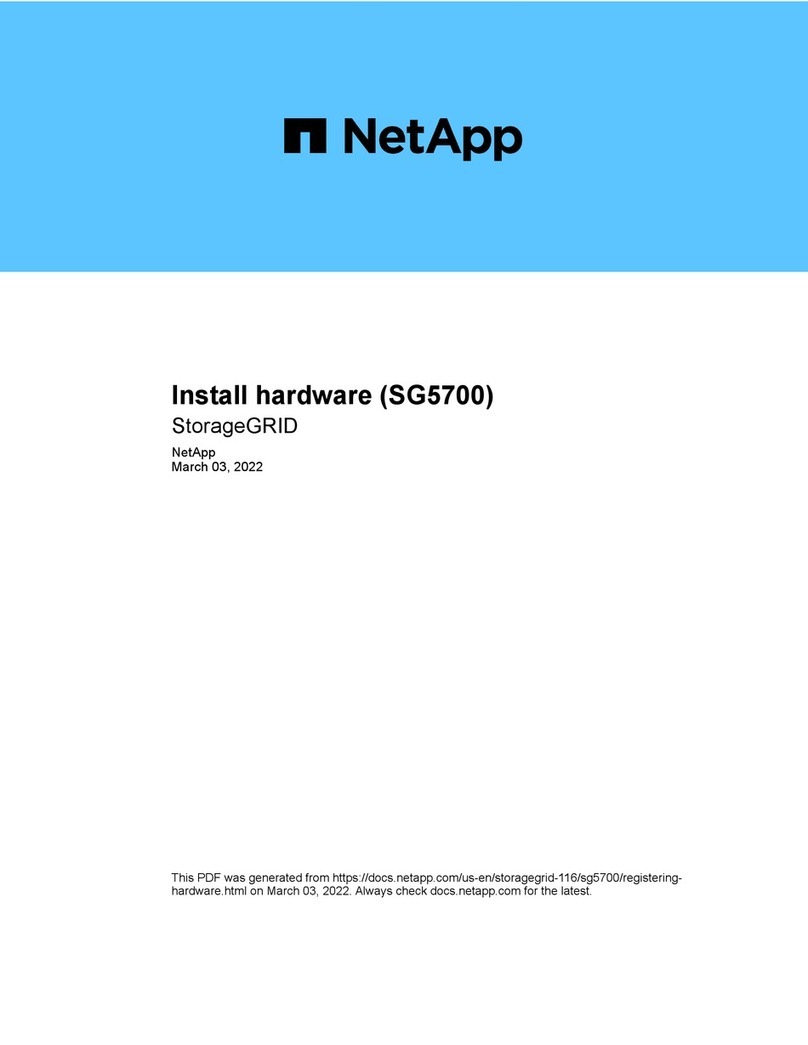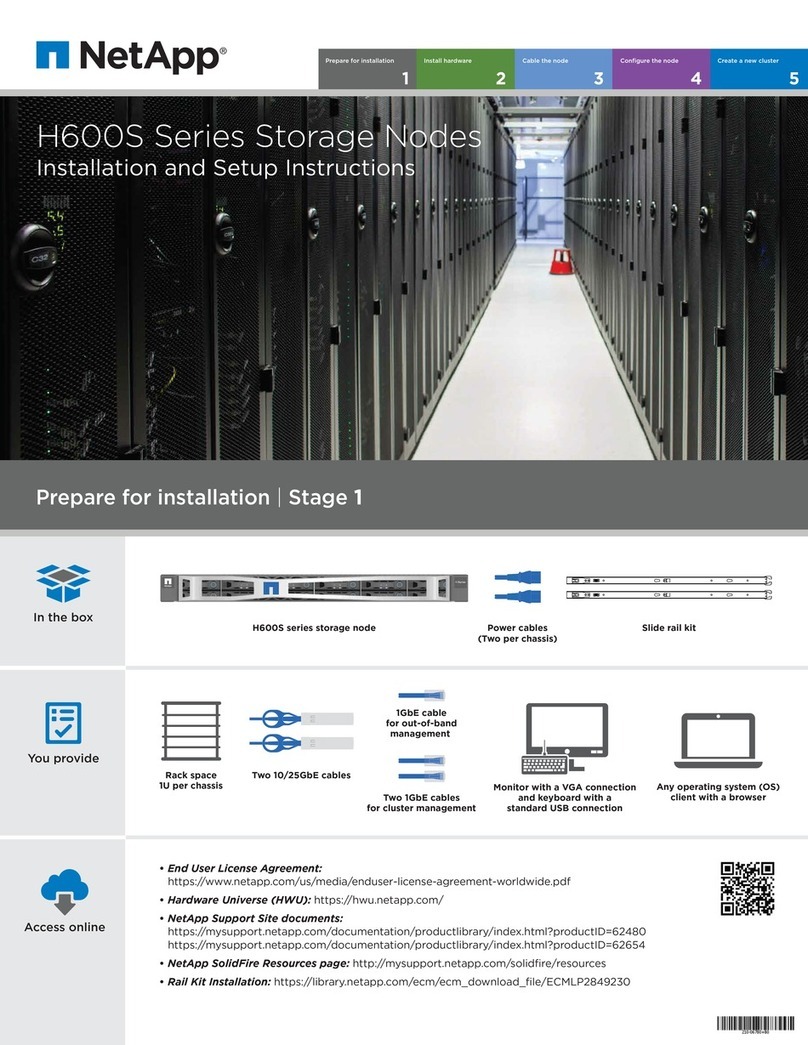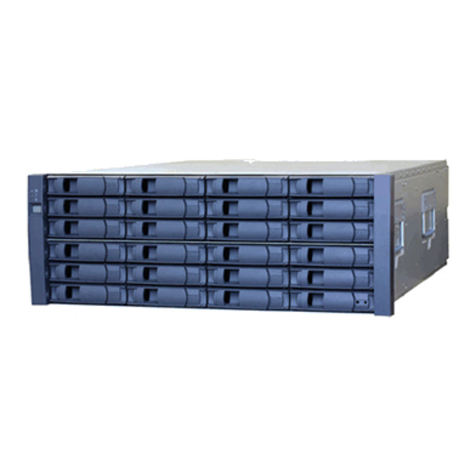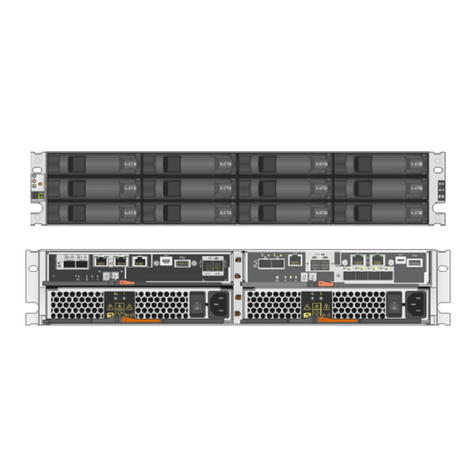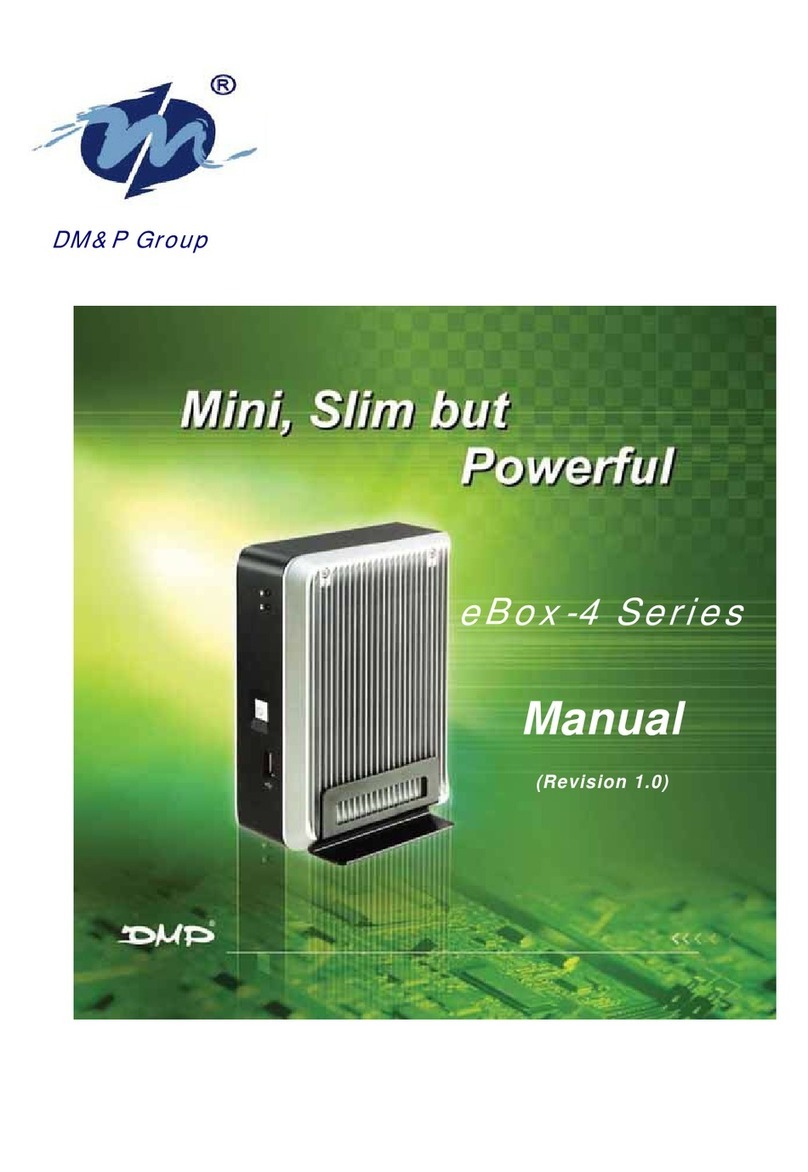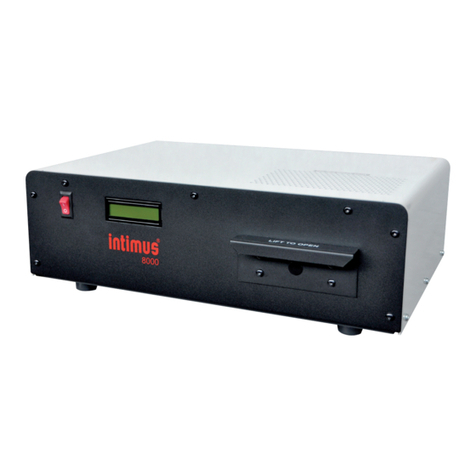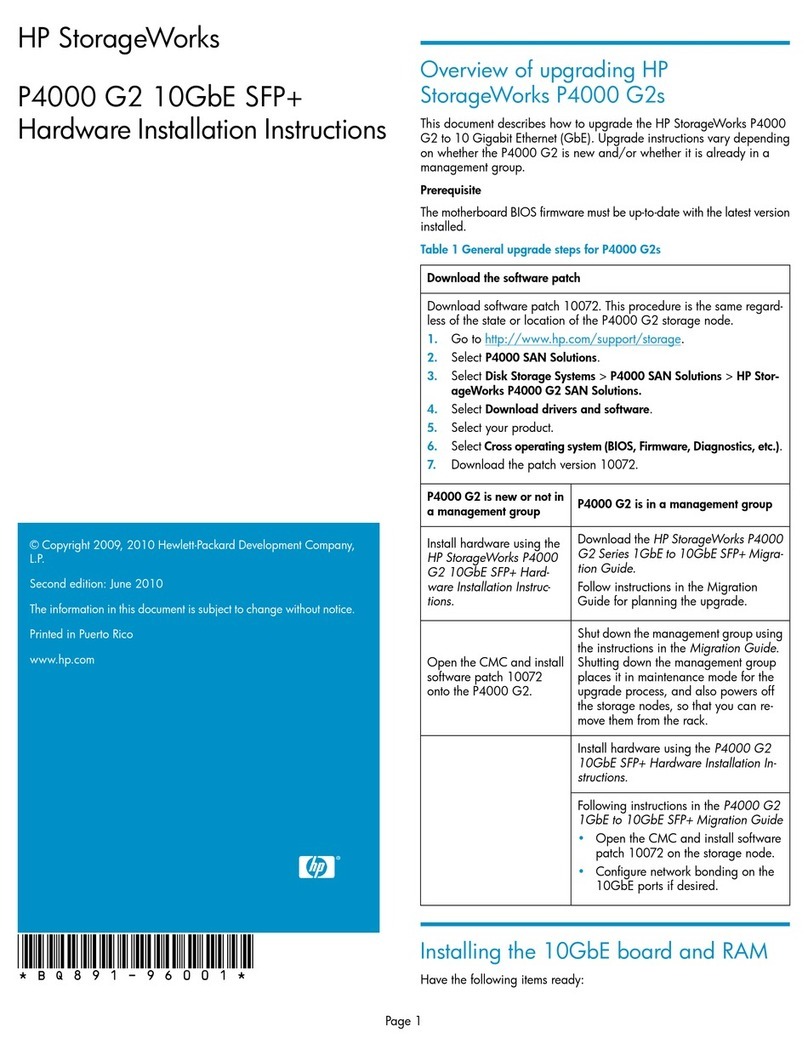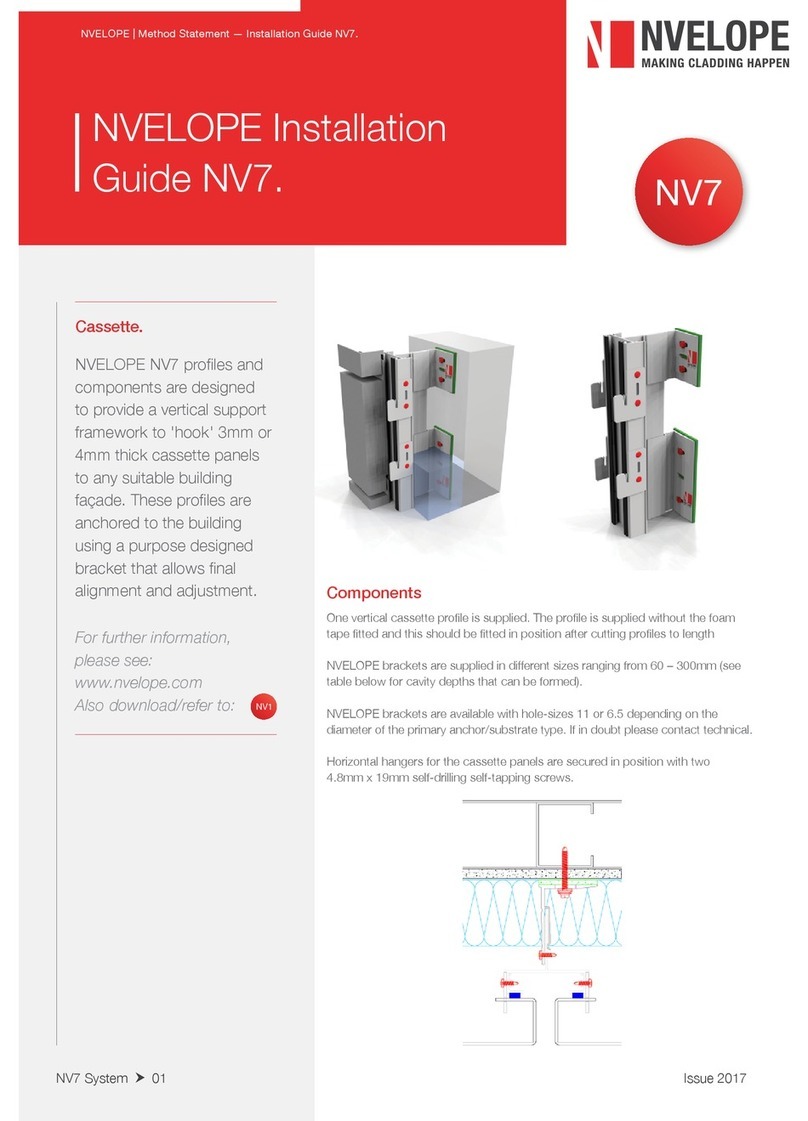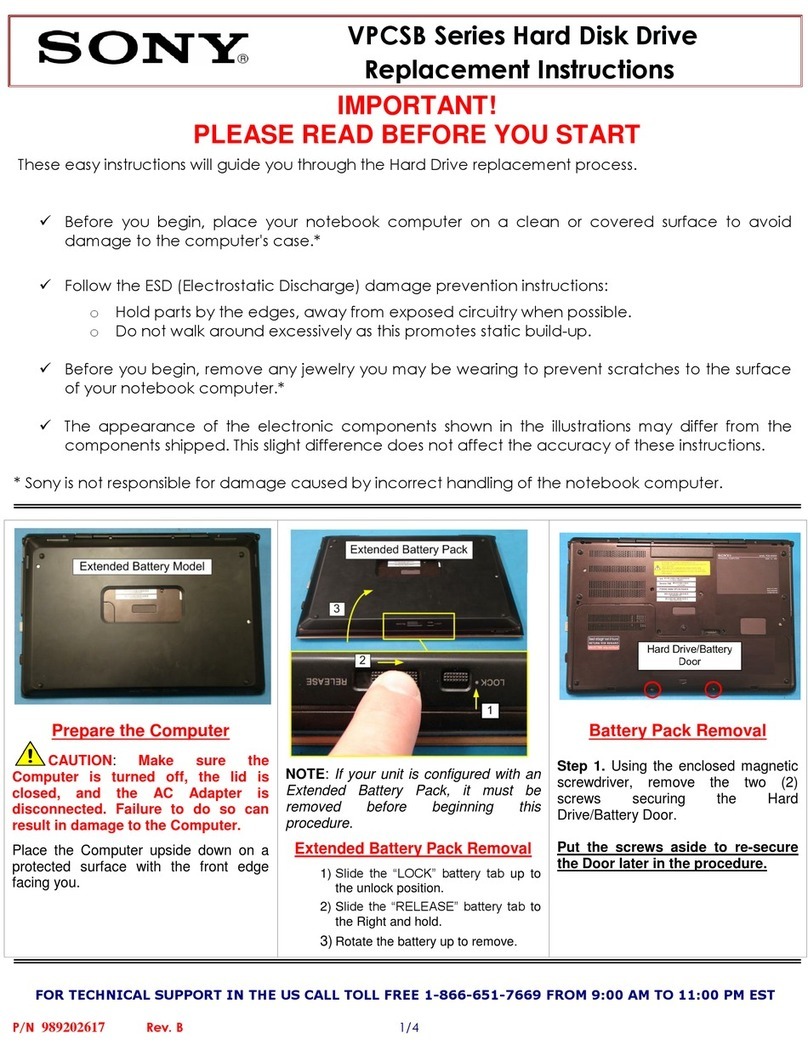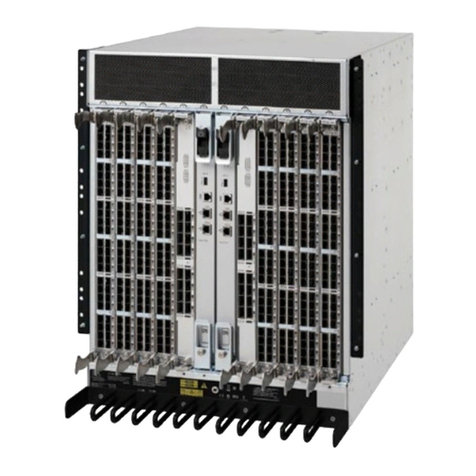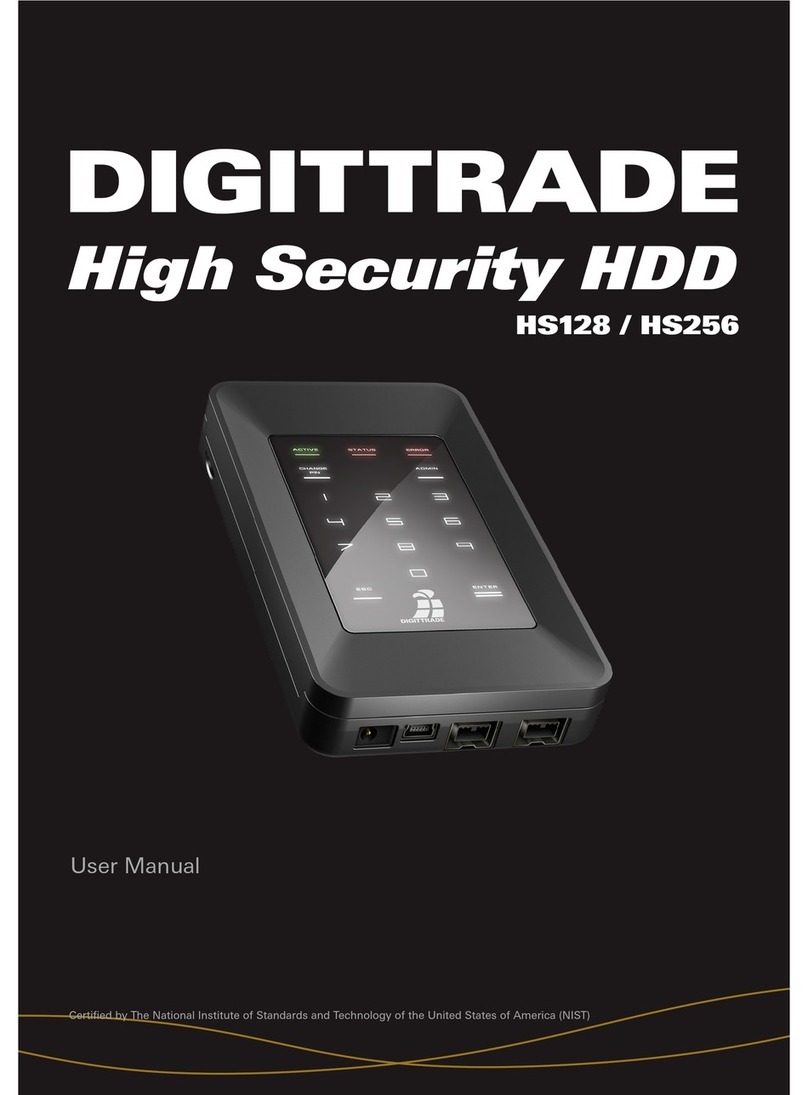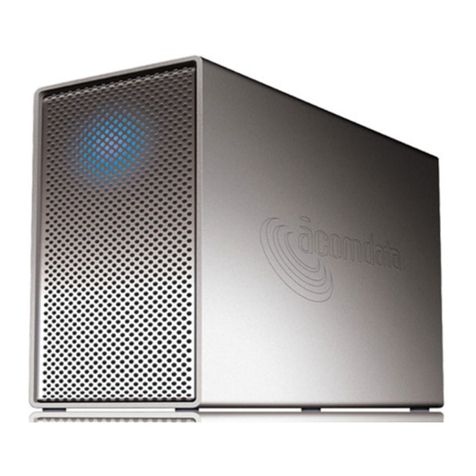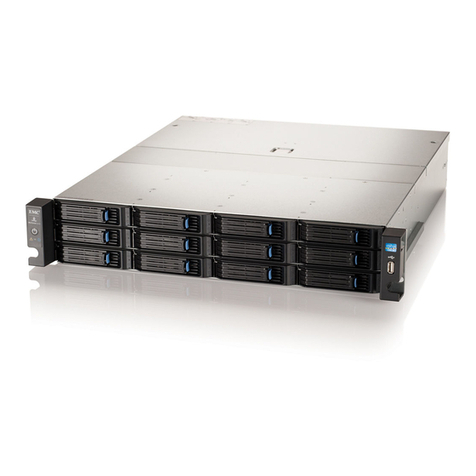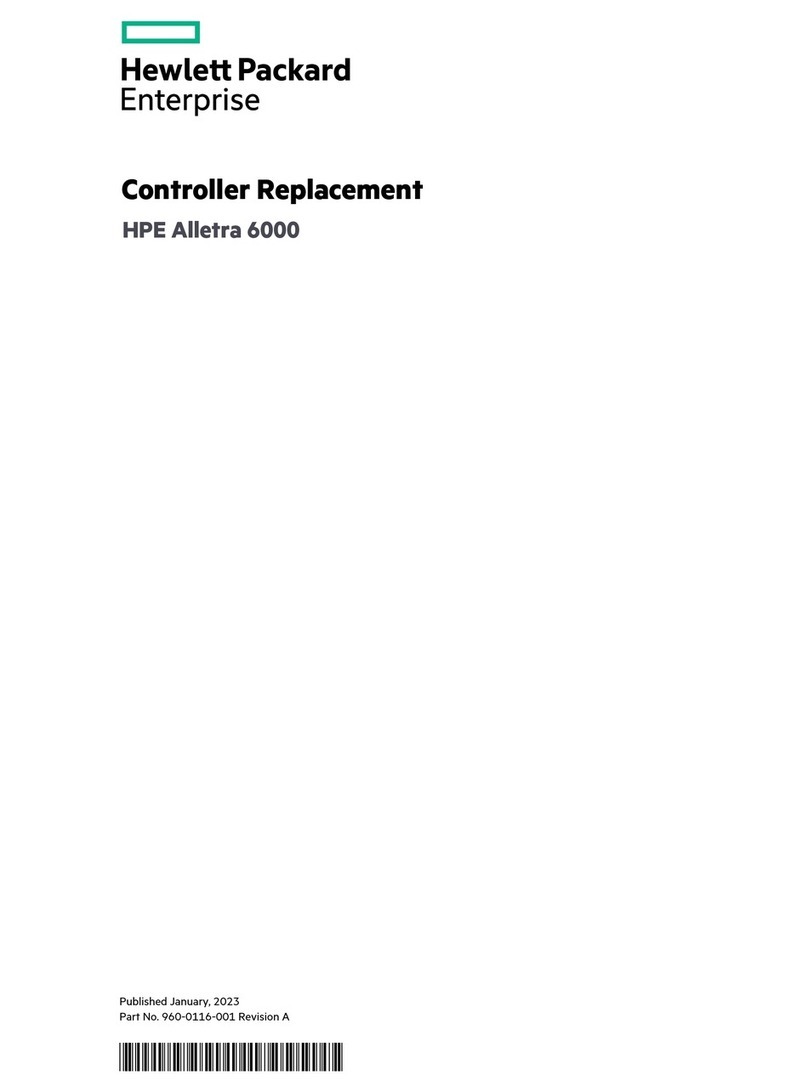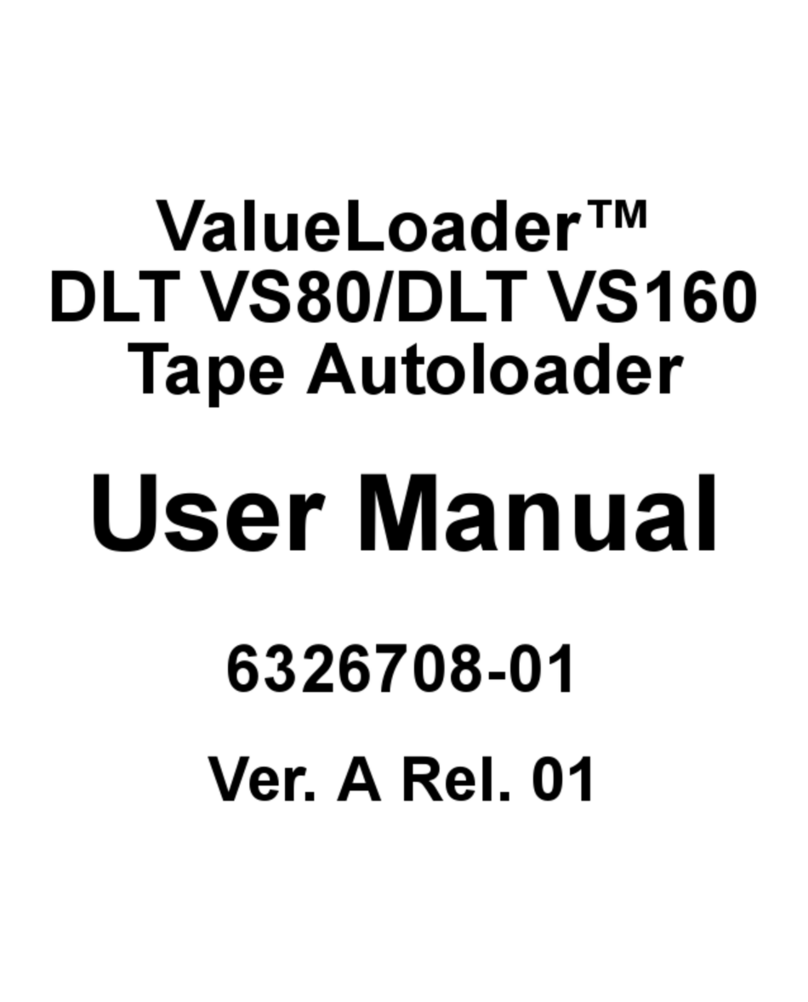NetApp HCI User manual

NetApp HCI configuration and management
documentation
HCI
NetApp
March 06, 2021
This PDF was generated from https://docs.netapp.com/us-en/hci/docs/index.html on March 06, 2021.
Always check docs.netapp.com for the latest.

Table of Contents
NetApp HCI configuration and management documentation. . . . . . . . . . . . . . . . . . . . . . . . . . . . . . . . . . . . . . . . Ê1
Discover what’s new. . . . . . . . . . . . . . . . . . . . . . . . . . . . . . . . . . . . . . . . . . . . . . . . . . . . . . . . . . . . . . . . . . . . . Ê1
Get started with NetApp HCI . . . . . . . . . . . . . . . . . . . . . . . . . . . . . . . . . . . . . . . . . . . . . . . . . . . . . . . . . . . . . . Ê1
Release Notes . . . . . . . . . . . . . . . . . . . . . . . . . . . . . . . . . . . . . . . . . . . . . . . . . . . . . . . . . . . . . . . . . . . . . . . . . . . Ê2
What’s new in NetApp HCI. . . . . . . . . . . . . . . . . . . . . . . . . . . . . . . . . . . . . . . . . . . . . . . . . . . . . . . . . . . . . . . . Ê2
Additional release information . . . . . . . . . . . . . . . . . . . . . . . . . . . . . . . . . . . . . . . . . . . . . . . . . . . . . . . . . . . . . Ê4
Concepts . . . . . . . . . . . . . . . . . . . . . . . . . . . . . . . . . . . . . . . . . . . . . . . . . . . . . . . . . . . . . . . . . . . . . . . . . . . . . . . Ê6
NetApp HCI product overview . . . . . . . . . . . . . . . . . . . . . . . . . . . . . . . . . . . . . . . . . . . . . . . . . . . . . . . . . . . . . Ê6
User accounts . . . . . . . . . . . . . . . . . . . . . . . . . . . . . . . . . . . . . . . . . . . . . . . . . . . . . . . . . . . . . . . . . . . . . . . . . Ê7
Data protection. . . . . . . . . . . . . . . . . . . . . . . . . . . . . . . . . . . . . . . . . . . . . . . . . . . . . . . . . . . . . . . . . . . . . . . . . Ê9
Clusters . . . . . . . . . . . . . . . . . . . . . . . . . . . . . . . . . . . . . . . . . . . . . . . . . . . . . . . . . . . . . . . . . . . . . . . . . . . . . Ê12
Nodes. . . . . . . . . . . . . . . . . . . . . . . . . . . . . . . . . . . . . . . . . . . . . . . . . . . . . . . . . . . . . . . . . . . . . . . . . . . . . . . Ê15
Storage. . . . . . . . . . . . . . . . . . . . . . . . . . . . . . . . . . . . . . . . . . . . . . . . . . . . . . . . . . . . . . . . . . . . . . . . . . . . . . Ê16
NetApp HCI licensing . . . . . . . . . . . . . . . . . . . . . . . . . . . . . . . . . . . . . . . . . . . . . . . . . . . . . . . . . . . . . . . . . . . Ê19
NetApp Hybrid Cloud Control configuration maximums. . . . . . . . . . . . . . . . . . . . . . . . . . . . . . . . . . . . . . . . . Ê19
NetApp HCI security. . . . . . . . . . . . . . . . . . . . . . . . . . . . . . . . . . . . . . . . . . . . . . . . . . . . . . . . . . . . . . . . . . . . Ê20
Performance and Quality of Service . . . . . . . . . . . . . . . . . . . . . . . . . . . . . . . . . . . . . . . . . . . . . . . . . . . . . . . Ê22
Requirements and pre-deployment tasks . . . . . . . . . . . . . . . . . . . . . . . . . . . . . . . . . . . . . . . . . . . . . . . . . . . . . Ê25
Requirements for NetApp HCI deployment overview. . . . . . . . . . . . . . . . . . . . . . . . . . . . . . . . . . . . . . . . . . . Ê25
Network port requirements. . . . . . . . . . . . . . . . . . . . . . . . . . . . . . . . . . . . . . . . . . . . . . . . . . . . . . . . . . . . . . . Ê25
Network and switch requirements . . . . . . . . . . . . . . . . . . . . . . . . . . . . . . . . . . . . . . . . . . . . . . . . . . . . . . . . . Ê30
Network cable requirements . . . . . . . . . . . . . . . . . . . . . . . . . . . . . . . . . . . . . . . . . . . . . . . . . . . . . . . . . . . . . Ê31
IP address requirements . . . . . . . . . . . . . . . . . . . . . . . . . . . . . . . . . . . . . . . . . . . . . . . . . . . . . . . . . . . . . . . . Ê32
Network configuration . . . . . . . . . . . . . . . . . . . . . . . . . . . . . . . . . . . . . . . . . . . . . . . . . . . . . . . . . . . . . . . . . . Ê33
DNS and timekeeping requirements . . . . . . . . . . . . . . . . . . . . . . . . . . . . . . . . . . . . . . . . . . . . . . . . . . . . . . . Ê41
Environmental requirements . . . . . . . . . . . . . . . . . . . . . . . . . . . . . . . . . . . . . . . . . . . . . . . . . . . . . . . . . . . . . Ê42
Protection domains . . . . . . . . . . . . . . . . . . . . . . . . . . . . . . . . . . . . . . . . . . . . . . . . . . . . . . . . . . . . . . . . . . . . Ê42
Witness Node resource requirements for two-node storage clusters . . . . . . . . . . . . . . . . . . . . . . . . . . . . . . Ê42
Get started with NetApp HCI . . . . . . . . . . . . . . . . . . . . . . . . . . . . . . . . . . . . . . . . . . . . . . . . . . . . . . . . . . . . . . . Ê44
NetApp HCI installation and deployment overview . . . . . . . . . . . . . . . . . . . . . . . . . . . . . . . . . . . . . . . . . . . . Ê44
Install H-series hardware . . . . . . . . . . . . . . . . . . . . . . . . . . . . . . . . . . . . . . . . . . . . . . . . . . . . . . . . . . . . . . . . Ê50
Configure LACP for optimal storage performance . . . . . . . . . . . . . . . . . . . . . . . . . . . . . . . . . . . . . . . . . . . . . Ê64
Validate your environment with Active IQ Config Advisor. . . . . . . . . . . . . . . . . . . . . . . . . . . . . . . . . . . . . . . . Ê64
Configure IPMI for each node . . . . . . . . . . . . . . . . . . . . . . . . . . . . . . . . . . . . . . . . . . . . . . . . . . . . . . . . . . . . Ê67
Deploy NetApp HCI . . . . . . . . . . . . . . . . . . . . . . . . . . . . . . . . . . . . . . . . . . . . . . . . . . . . . . . . . . . . . . . . . . . . . . Ê70
Access the NetApp Deployment Engine . . . . . . . . . . . . . . . . . . . . . . . . . . . . . . . . . . . . . . . . . . . . . . . . . . . . Ê70
Start your deployment . . . . . . . . . . . . . . . . . . . . . . . . . . . . . . . . . . . . . . . . . . . . . . . . . . . . . . . . . . . . . . . . . . Ê73
Configure VMware vSphere . . . . . . . . . . . . . . . . . . . . . . . . . . . . . . . . . . . . . . . . . . . . . . . . . . . . . . . . . . . . . . Ê73
Configuring NetApp HCI credentials . . . . . . . . . . . . . . . . . . . . . . . . . . . . . . . . . . . . . . . . . . . . . . . . . . . . . . . Ê75
Select a network topology . . . . . . . . . . . . . . . . . . . . . . . . . . . . . . . . . . . . . . . . . . . . . . . . . . . . . . . . . . . . . . . Ê76
Inventory selection . . . . . . . . . . . . . . . . . . . . . . . . . . . . . . . . . . . . . . . . . . . . . . . . . . . . . . . . . . . . . . . . . . . . . Ê77
Configure network settings. . . . . . . . . . . . . . . . . . . . . . . . . . . . . . . . . . . . . . . . . . . . . . . . . . . . . . . . . . . . . . . Ê79
Review and deploy the configuration . . . . . . . . . . . . . . . . . . . . . . . . . . . . . . . . . . . . . . . . . . . . . . . . . . . . . . . Ê82

Post-deployment tasks. . . . . . . . . . . . . . . . . . . . . . . . . . . . . . . . . . . . . . . . . . . . . . . . . . . . . . . . . . . . . . . . . . Ê83
Manage NetApp HCI . . . . . . . . . . . . . . . . . . . . . . . . . . . . . . . . . . . . . . . . . . . . . . . . . . . . . . . . . . . . . . . . . . . . . Ê92
NetApp HCI management overview. . . . . . . . . . . . . . . . . . . . . . . . . . . . . . . . . . . . . . . . . . . . . . . . . . . . . . . . Ê92
Update vCenter and ESXi credentials . . . . . . . . . . . . . . . . . . . . . . . . . . . . . . . . . . . . . . . . . . . . . . . . . . . . . . Ê92
Manage NetApp HCI storage . . . . . . . . . . . . . . . . . . . . . . . . . . . . . . . . . . . . . . . . . . . . . . . . . . . . . . . . . . . . . Ê94
Work with the management node. . . . . . . . . . . . . . . . . . . . . . . . . . . . . . . . . . . . . . . . . . . . . . . . . . . . . . . . . Ê114
Power your NetApp HCI system off or on . . . . . . . . . . . . . . . . . . . . . . . . . . . . . . . . . . . . . . . . . . . . . . . . . . Ê146
Monitor your NetApp HCI system with NetApp Hybrid Cloud Control . . . . . . . . . . . . . . . . . . . . . . . . . . . . . . . Ê150
Monitor storage and compute resources on the Hybrid Cloud Control Dashboard . . . . . . . . . . . . . . . . . . . Ê150
View your inventory on the Nodes page . . . . . . . . . . . . . . . . . . . . . . . . . . . . . . . . . . . . . . . . . . . . . . . . . . . Ê156
Edit Baseboard Management Controller connection information. . . . . . . . . . . . . . . . . . . . . . . . . . . . . . . . . Ê158
Monitor volumes on your storage cluster . . . . . . . . . . . . . . . . . . . . . . . . . . . . . . . . . . . . . . . . . . . . . . . . . . . Ê161
Monitor performance, capacity, and cluster health with SolidFire Active IQ. . . . . . . . . . . . . . . . . . . . . . . . . Ê163
Collect logs for troubleshooting . . . . . . . . . . . . . . . . . . . . . . . . . . . . . . . . . . . . . . . . . . . . . . . . . . . . . . . . . . Ê164
Upgrade your NetApp HCI or SolidFire system . . . . . . . . . . . . . . . . . . . . . . . . . . . . . . . . . . . . . . . . . . . . . . . . Ê168
Upgrades overview . . . . . . . . . . . . . . . . . . . . . . . . . . . . . . . . . . . . . . . . . . . . . . . . . . . . . . . . . . . . . . . . . . . Ê168
Upgrade sequences . . . . . . . . . . . . . . . . . . . . . . . . . . . . . . . . . . . . . . . . . . . . . . . . . . . . . . . . . . . . . . . . . . . Ê168
System upgrade procedures . . . . . . . . . . . . . . . . . . . . . . . . . . . . . . . . . . . . . . . . . . . . . . . . . . . . . . . . . . . . Ê171
vSphere upgrade sequences with vCenter Plug-in . . . . . . . . . . . . . . . . . . . . . . . . . . . . . . . . . . . . . . . . . . . Ê252
Expand your NetApp HCI system. . . . . . . . . . . . . . . . . . . . . . . . . . . . . . . . . . . . . . . . . . . . . . . . . . . . . . . . . . . Ê254
Expansion overview . . . . . . . . . . . . . . . . . . . . . . . . . . . . . . . . . . . . . . . . . . . . . . . . . . . . . . . . . . . . . . . . . . . Ê254
Expand NetApp HCI storage resources . . . . . . . . . . . . . . . . . . . . . . . . . . . . . . . . . . . . . . . . . . . . . . . . . . . . Ê254
Expand NetApp HCI compute resources . . . . . . . . . . . . . . . . . . . . . . . . . . . . . . . . . . . . . . . . . . . . . . . . . . . Ê256
Expand NetApp HCI storage and compute resources at the same time . . . . . . . . . . . . . . . . . . . . . . . . . . . Ê259
Remove Witness Nodes after expanding cluster . . . . . . . . . . . . . . . . . . . . . . . . . . . . . . . . . . . . . . . . . . . . . Ê262
Use Rancher on NetApp HCI . . . . . . . . . . . . . . . . . . . . . . . . . . . . . . . . . . . . . . . . . . . . . . . . . . . . . . . . . . . . . . Ê264
Rancher on NetApp HCI overview . . . . . . . . . . . . . . . . . . . . . . . . . . . . . . . . . . . . . . . . . . . . . . . . . . . . . . . . Ê264
Rancher on NetApp HCI concepts . . . . . . . . . . . . . . . . . . . . . . . . . . . . . . . . . . . . . . . . . . . . . . . . . . . . . . . . Ê266
Requirements for Rancher on NetApp HCI . . . . . . . . . . . . . . . . . . . . . . . . . . . . . . . . . . . . . . . . . . . . . . . . . Ê267
Deploy Rancher on NetApp HCI . . . . . . . . . . . . . . . . . . . . . . . . . . . . . . . . . . . . . . . . . . . . . . . . . . . . . . . . . Ê269
Post deployment tasks . . . . . . . . . . . . . . . . . . . . . . . . . . . . . . . . . . . . . . . . . . . . . . . . . . . . . . . . . . . . . . . . . Ê274
Deploy user clusters and applications . . . . . . . . . . . . . . . . . . . . . . . . . . . . . . . . . . . . . . . . . . . . . . . . . . . . . Ê279
Manage Rancher on NetApp HCI . . . . . . . . . . . . . . . . . . . . . . . . . . . . . . . . . . . . . . . . . . . . . . . . . . . . . . . . Ê280
Monitor a Rancher on NetApp HCI implementation. . . . . . . . . . . . . . . . . . . . . . . . . . . . . . . . . . . . . . . . . . . Ê280
Upgrade Rancher on NetApp HCI . . . . . . . . . . . . . . . . . . . . . . . . . . . . . . . . . . . . . . . . . . . . . . . . . . . . . . . . Ê282
Remove a Rancher installation on NetApp HCI . . . . . . . . . . . . . . . . . . . . . . . . . . . . . . . . . . . . . . . . . . . . . . Ê288
Maintain H-series hardware . . . . . . . . . . . . . . . . . . . . . . . . . . . . . . . . . . . . . . . . . . . . . . . . . . . . . . . . . . . . . . . Ê290
H-series hardware maintenance overview . . . . . . . . . . . . . . . . . . . . . . . . . . . . . . . . . . . . . . . . . . . . . . . . . . Ê290
Replace 2U H-series chassis . . . . . . . . . . . . . . . . . . . . . . . . . . . . . . . . . . . . . . . . . . . . . . . . . . . . . . . . . . . . Ê290
Replace DC power supply units in H615C and H610S nodes . . . . . . . . . . . . . . . . . . . . . . . . . . . . . . . . . . . Ê297
Replace DIMMs in compute nodes . . . . . . . . . . . . . . . . . . . . . . . . . . . . . . . . . . . . . . . . . . . . . . . . . . . . . . . Ê299
Replace drives for storage nodes . . . . . . . . . . . . . . . . . . . . . . . . . . . . . . . . . . . . . . . . . . . . . . . . . . . . . . . . Ê308
Replace H410C nodes . . . . . . . . . . . . . . . . . . . . . . . . . . . . . . . . . . . . . . . . . . . . . . . . . . . . . . . . . . . . . . . . . Ê313
Replace H410S nodes . . . . . . . . . . . . . . . . . . . . . . . . . . . . . . . . . . . . . . . . . . . . . . . . . . . . . . . . . . . . . . . . . Ê332
Replace H610C and H615C nodes . . . . . . . . . . . . . . . . . . . . . . . . . . . . . . . . . . . . . . . . . . . . . . . . . . . . . . . Ê339

Replace H610S nodes . . . . . . . . . . . . . . . . . . . . . . . . . . . . . . . . . . . . . . . . . . . . . . . . . . . . . . . . . . . . . . . . . Ê345
Replace power supply units . . . . . . . . . . . . . . . . . . . . . . . . . . . . . . . . . . . . . . . . . . . . . . . . . . . . . . . . . . . . . Ê347
Replace SN2010, SN2100, and SN2700 switches . . . . . . . . . . . . . . . . . . . . . . . . . . . . . . . . . . . . . . . . . . . Ê349
Replace storage node in a two-node cluster . . . . . . . . . . . . . . . . . . . . . . . . . . . . . . . . . . . . . . . . . . . . . . . . Ê357
Legal notices . . . . . . . . . . . . . . . . . . . . . . . . . . . . . . . . . . . . . . . . . . . . . . . . . . . . . . . . . . . . . . . . . . . . . . . . . . Ê358
Copyright . . . . . . . . . . . . . . . . . . . . . . . . . . . . . . . . . . . . . . . . . . . . . . . . . . . . . . . . . . . . . . . . . . . . . . . . . . . Ê358
Trademarks . . . . . . . . . . . . . . . . . . . . . . . . . . . . . . . . . . . . . . . . . . . . . . . . . . . . . . . . . . . . . . . . . . . . . . . . . Ê358
Patents . . . . . . . . . . . . . . . . . . . . . . . . . . . . . . . . . . . . . . . . . . . . . . . . . . . . . . . . . . . . . . . . . . . . . . . . . . . . . Ê358
Privacy policy . . . . . . . . . . . . . . . . . . . . . . . . . . . . . . . . . . . . . . . . . . . . . . . . . . . . . . . . . . . . . . . . . . . . . . . . Ê358
Open source. . . . . . . . . . . . . . . . . . . . . . . . . . . . . . . . . . . . . . . . . . . . . . . . . . . . . . . . . . . . . . . . . . . . . . . . . Ê358

NetApp HCI configuration and management
documentation
NetApp HCI provides both storage and compute resources, combining them to build a
VMware vSphere environment backed by the capabilities of NetApp Element software.
You can upgrade, expand, and monitor your system with the NetApp Hybrid Cloud Control interface and
manage NetApp HCI resources with NetApp Element Plug-in for vCenter Server.
Discover what’s new
•What’s new in NetApp HCI
•What’s new in NetApp Element software
•What’s new in management services for Element software and NetApp HCI
•What’s new in NetApp Element Plug-in for vCenter Server
Get started with NetApp HCI
•NetApp HCI installation and deployment overview
•Review basic concepts
Find more information
•NetApp Element Plug-in for vCenter Server
•NetApp HCI Resources page

Release Notes
What’s new in NetApp HCI
NetApp periodically updates NetApp HCI to bring you new features, enhancements, and
bug fixes. NetApp HCI 1.8P1 includes Element 12.2 for storage clusters.
•The NetApp HCI 1.8P1 section describes new features and updates in NetApp HCI version 1.8P1.
•The Element 12.2 section describes new features and updates in NetApp Element 12.2.
NetApp HCI 1.8P1
NetApp HCI 1.8P1 includes security and stability improvements.
NetApp HCI documentation enhancements
You can now access NetApp HCI upgrading, expansion, monitoring, and concepts information in an easy-to-
navigate format here.
NetApp Element Plug-in for vCenter Server 4.5 availability
The NetApp Element Plug-in for vCenter Server 4.5 is available outside of the management node 12.2 and
NetApp HCI 1.8P1 releases. To upgrade the plug-in, follow the instructions in the NetApp HCI Upgrades
documentation.
NetApp Hybrid Cloud Control enhancements
NetApp Hybrid Cloud Control is enhanced for version 1.8P1. Learn more.
Element 12.2
NetApp HCI 1.8P1 includes Element 12.2 for storage clusters. Element 12.2 introduces SolidFire Enterprise
SDS, software encryption at rest, maintenance mode, enhanced volume access security, Fully Qualified
Domain Name (FQDN) access to UIs, storage node firmware updates, and security updates.
SolidFire Enterprise SDS
Element 12.2 introduces SolidFire Enterprise SDS (eSDS). SolidFire eSDS provides the benefits of SolidFire
scale out technology and NetApp Element software data services on the hardware of your choice that meets
the reference configuration for SolidFire eSDS. Learn more.
The following are new Element API methods related to SolidFire eSDS (Element 12.2 API information for
SolidFire eSDS has more information):
•GetLicenseKey
•SetLicenseKey
Software encryption at rest
Element 12.2 introduces software encryption at rest, which you can enable when you create a storage cluster
(and is enabled by default when you create a SolidFire Enterprise SDS storage cluster). This feature encrypts

all data stored on the SSDs in the storage nodes and causes only a very small (~2%) performance impact on
client IO.
The following are Element API methods related to software encryption at rest (the Element API Reference
Guide has more information):
•CreateCluster
Maintenance mode
Element 12.2 introduces maintenance mode, which enables you to take a storage node offline for maintenance
such as software upgrades or host repairs, while preventing a full sync of all data. If one or more nodes need
maintenance, you can minimize the I/O impact to the rest of the storage cluster by enabling maintenance mode
for those nodes before you begin. You can use maintenance mode with both appliance nodes as well as
SolidFire eSDS nodes.
Enhanced volume access security
You can now restrict volume access to certain initiators based on VLAN (virtual network) association. You can
associate new or existing initiators with one or more virtual networks, restricting that initiator to iSCSI targets
accessible via those virtual networks.
The following are updated Element API methods related to these security improvements (the Element API
Reference Guide has more information):
•CreateInitiators
•ModifyInitiators
•AddAccount
•ModifyAccount
Fully Qualified Domain Name (FQDN) access to UIs
Element 12.2 supports cluster web interface access using FQDNs. On Element 12.2 storage clusters, if you
use the FQDN to access web user interfaces such as the Element web UI, per-node UI, or management node
UI, you must first add a storage cluster setting to identify the FQDN used by the cluster. This setting enables
the cluster to properly redirect a login session and facilitates better integration with external services like key
managers and identity providers for multi-factor authentication. This feature requires management services
version 2.15 or later. Learn more.
Storage node firmware updates
Element 12.2 includes firmware updates for storage nodes. Learn more.
Security enhancements
Element 12.2 resolves security vulnerabilities for storage nodes and the management node. Learn more about
these security enhancements.
New SMART warning for failing drives
Element 12.2 now performs periodic health checks on SolidFire appliance drives using SMART health data
from the drives. A drive that fails the SMART health check might be close to failure. If a drive fails the SMART

health check, a new critical severity cluster fault appears: Drive with serial: <serial number> in
slot: <node slot><drive slot> has failed the SMART overall health check. To
resolve this fault, replace the drive
Find more information
•NetApp Hybrid Cloud Control and Management Services Release Notes
•NetApp Element Plug-in for vCenter Server
•NetApp HCI Resources page
•SolidFire and Element Software Documentation Center
•Firmware and driver versions for NetApp HCI and NetApp Element software
Additional release information
You can find links to the latest and earlier release notes for various components of the
NetApp HCI and Element storage environment.
You will be prompted to log in using your NetApp Support Site credentials.
NetApp HCI
•NetApp HCI 1.8P1 Release Notes
•NetApp HCI 1.8 Release Notes
•NetApp HCI 1.7P1 Release Notes
NetApp Element software
•NetApp Element Software 12.2 Release Notes
•NetApp Element Software 12.0 Release Notes
•NetApp Element Software 11.8 Release Notes
•NetApp Element Software 11.7 Release Notes
•NetApp Element Software 11.5.1 Release Notes
•NetApp Element Software 11.3P1 Release Notes
Management services
•Management Services Release Notes
NetApp Element Plug-in for vCenter Server
•vCenter Plug-in 4.6 Release Notes
•vCenter Plug-in 4.5 Release Notes
•vCenter Plug-in 4.4 Release Notes
•vCenter Plug-in 4.3 Release Notes

Compute firmware
•Compute Firmware Bundle 2.76 Release Notes (latest)
•Compute Firmware Bundle 2.27 Release Notes
•Compute Firmware Bundle 12.2.109 Release Notes
Storage firmware
•Storage firmware Bundle 2.76 Release Notes (latest)
•Storage firmware Bundle 2.27 Release Notes
•H610S BMC 3.84.07 Release Notes

Concepts
NetApp HCI product overview
NetApp HCI is an enterprise-scale hybrid cloud infrastructure design that combines
storage, compute, networking, and hypervisor—and adds capabilities that span public
and private clouds.
NetApp’s disaggregated hybrid cloud infrastructure allows independent scaling of compute and storage,
adapting to workloads with guaranteed performance.
•Meets hybrid multicloud demand
•Scales compute and storage independently
•Simplifies data services orchestration across hybrid multiclouds
Components of NetApp HCI
Here is an overview of the various components of the NetApp HCI environment:
•NetApp HCI provides both storage and compute resources. You use the NetApp Deployment Engine
wizard to deploy NetApp HCI. After successful deployment, compute nodes appear as ESXi hosts and you
can manage them in VMware vSphere Web Client.
•Management services or microservices include the Active IQ collector, QoSSIOC for the vCenter Plug-in,
and mNode service; they are updated frequently as service bundles. As of the Element 11.3 release,
management services are hosted on the management node, allowing for quicker updates of select
software services outside of major releases. The management node (mNode) is a virtual machine that
runs in parallel with one or more Element software-based storage clusters. It is used to upgrade and
provide system services including monitoring and telemetry, manage cluster assets and settings, run
system tests and utilities, and enable NetApp Support access for troubleshooting.
Learn more about management services releases.
•NetApp Hybrid Cloud Control enables you to manage NetApp HCI. You can upgrade management
services, expand your system, collect logs, and monitor your installation by using NetApp SolidFire Active
IQ. You log in to NetApp Hybrid Cloud Control by browsing to the IP address of the management node.
•The NetApp Element Plug-in for vCenter Server (VCP) is a web-based tool integrated with the vSphere
user interface (UI). The plug-in is an extension and scalable, user-friendly interface for VMware vSphere
that can manage and monitor storage clusters running NetApp Element software. The plug-in provides an
alternative to the Element UI. You can use the plug-in user interface to discover and configure clusters, and
to manage, monitor, and allocate storage from cluster capacity to configure datastores and virtual
datastores (for virtual volumes). A cluster appears on the network as a single local group that is
represented to hosts and administrators by virtual IP addresses. You can also monitor cluster activity with
real-time reporting, including error and alert messaging for any event that might occur while performing
various operations.
Learn more about VCP.
•By default, NetApp HCI sends performance and alert statistics to the NetApp SolidFire Active IQ service.

As part of your normal support contract, NetApp Support monitors this data and alerts you to any
performance bottlenecks or potential system issues. You need to create a NetApp Support account if you
do not already have one (even if you have an existing SolidFire Active IQ account) so that you can take
advantage of this service.
Learn more about NetApp SolidFire Active IQ.
NetApp HCI URLs
Here are the common URLs you use with NetApp HCI:
URL Description
https://[IPv4 address of Bond1G
interface on a storage node]
Access the NetApp Deployment Engine wizard to
install and configure NetApp HCI. Learn more.
https://[management node IP address] Access NetApp Hybrid Cloud Control to upgrade,
expand, and monitor your NetApp HCI installation,
and update management services. Learn more.
https://[IP address]:442 From the per-node UI, access network and cluster
settings and utilize system tests and utilities. Learn
more.
https://[management node IP
address]:9443
Register the vCenter Plug-in package in the vSphere
Web Client.
https://activeiq.solidfire.com Monitor data and receive alerts to any performance
bottlenecks or potential system issues.
https://[management node IP
address]/mnode
Manually update management services using the
REST API UI from the management node.
https://[storage cluster MVIP address] Access the NetApp Element software UI.
Find more information
•NetApp Element Plug-in for vCenter Server
•NetApp HCI Resources page
User accounts
To access storage resources on your system, you’ll need to set up user accounts.
User account management
User accounts are used to control access to the storage resources on a NetApp Element software-based
network. At least one user account is required before a volume can be created.
When you create a volume, it is assigned to an account. If you have created a virtual volume, the account is
the storage container.
Here are some additional considerations:

•The account contains the CHAP authentication required to access the volumes assigned to it.
•An account can have up to 2000 volumes assigned to it, but a volume can belong to only one account.
•User accounts can be managed from the NetApp Element Management extension point.
Using NetApp Hybrid Cloud Control, you can create and manage the following types of accounts:
•Administrator user accounts for the storage cluster
•Authoritative user accounts
•Volume accounts, specific only to the storage cluster on which they were created.
Storage cluster administrator accounts
There are two types of administrator accounts that can exist in a storage cluster running NetApp Element
software:
•Primary cluster administrator account: This administrator account is created when the cluster is created.
This account is the primary administrative account with the highest level of access to the cluster. This
account is analogous to a root user in a Linux system. You can change the password for this administrator
account.
•Cluster administrator account: You can give a cluster administrator account a limited range of
administrative access to perform specific tasks within a cluster. The credentials assigned to each cluster
administrator account are used to authenticate API and Element UI requests within the storage system.
A local (non-LDAP) cluster administrator account is required to access active nodes in a
cluster via the per-node UI. Account credentials are not required to access a node that is not
yet part of a cluster.
You can manage cluster administrator accounts by creating, deleting, and editing cluster administrator
accounts, changing the cluster administrator password, and configuring LDAP settings to manage system
access for users.
For details, see the SolidFire and Element Documentation Center.
Authoritative user accounts
Authoritative user accounts can authenticate against any storage asset associated with the NetApp Hybrid
Cloud Control instance of nodes and clusters. With this account, you can manage volumes, accounts, access
groups, and more across all clusters.
Authoritative user accounts are managed from the top right menu User Management option in NetApp Hybrid
Cloud Control.
The authoritative storage cluster is the storage cluster that NetApp Hybrid Cloud Control uses to authenticate
users.
All users created on the authoritative storage cluster can log into the NetApp Hybrid Cloud Control. Users
created on other storage clusters cannot log into Hybrid Cloud Control.
•If your management node only has one storage cluster, then it is the authoritative cluster.
•If your management node has two or more storage clusters, one of those clusters is assigned as the
authoritative cluster and only users from that cluster can log into NetApp Hybrid Cloud Control.

While many NetApp Hybrid Cloud Control features work with multiple storage clusters, authentication and
authorization have necessary limitations. The limitation around authentication and authorization is that users
from the authoritative cluster can execute actions on other clusters tied to NetApp Hybrid Cloud Control even if
they are not a user on the other storage clusters. Before proceeding with managing multiple storage clusters,
you should ensure that users defined on the authoritative clusters are defined on all other storage clusters with
the same permissions. You can manage users from NetApp Hybrid Cloud Control.
Volume accounts
Volume-specific accounts are specific only to the storage cluster on which they were created. These accounts
enable you to set permissions on specific volumes across the network, but have no effect outside of those
volumes.
Volume accounts are managed within the NetApp Hybrid Cloud Control Volumes table.
Find more information
•Manage user accounts
•Learn about clusters
•NetApp HCI Resources page
•NetApp Element Plug-in for vCenter Server
•SolidFire and Element Documentation Center
Data protection
NetApp HCI data protection terms include different types of remote replication, volume
snapshots, volume cloning, protection domains, and high availability with double Helix
technology.
NetApp HCI data protection includes the following concepts:
•Remote replication types
•Volume snapshots for data protection
•Volume clones
•Backup and restore process overview for SolidFire storage
•Protection domains
•Double Helix high availability
Remote replication types
Remote replication of data can take the following forms:
•Synchronous and asynchronous replication between clusters
•Snapshot-only replication
•Replication between Element and ONTAP clusters using SnapMirror
See TR-4741: NetApp Element Software Remote Replication.

Synchronous and asynchronous replication between clusters
For clusters running NetApp Element software, real-time replication enables the quick creation of remote
copies of volume data.
You can pair a storage cluster with up to four other storage clusters. You can replicate volume data
synchronously or asynchronously from either cluster in a cluster pair for failover and failback scenarios.
Synchronous replication
Synchronous replication continuously replicates data from the source cluster to the target cluster and is
affected by latency, packet loss, jitter, and bandwidth.
Synchronous replication is appropriate for the following situations:
•Replication of several systems over a short distance
•A disaster recovery site that is geographically local to the source
•Time-sensitive applications and the protection of databases
•Business continuity applications that require the secondary site to act as the primary site when the primary
site is down
Asynchronous replication
Asynchronous replication continuously replicates data from a source cluster to a target cluster without waiting
for the acknowledgments from the target cluster. During asynchronous replication, writes are acknowledged to
the client (application) after they are committed on the source cluster.
Asynchronous replication is appropriate for the following situations:
•The disaster recovery site is far from the source and the application does not tolerate latencies induced by
the network.
•There are bandwidth limitations on the network connecting the source and target clusters.
Snapshot-only replication
Snapshot-only data protection replicates changed data at specific points of time to a remote cluster. Only those
snapshots that are created on the source cluster are replicated. Active writes from the source volume are not.
You can set the frequency of the snapshot replications.
Snapshot replication does not affect asynchronous or synchronous replication.
Replication between Element and ONTAP clusters using SnapMirror
With NetApp SnapMirror technology, you can replicate snapshots that were taken using NetApp Element
software to ONTAP for disaster recovery purposes. In a SnapMirror relationship, Element is one endpoint and
ONTAP is the other.
SnapMirror is a NetApp Snapshot™ replication technology that facilitates disaster recovery, designed for
failover from primary storage to secondary storage at a geographically remote site. SnapMirror technology
creates a replica, or mirror, of the working data in secondary storage from which you can continue to serve
data if an outage occurs at the primary site. Data is mirrored at the volume level.
The relationship between the source volume in primary storage and the destination volume in secondary

storage is called a data protection relationship. The clusters are referred to as endpoints in which the volumes
reside and the volumes that contain the replicated data must be peered. A peer relationship enables clusters
and volumes to exchange data securely.
SnapMirror runs natively on the NetApp ONTAP controllers and is integrated into Element, which runs on
NetApp HCI and SolidFire clusters. The logic to control SnapMirror resides in ONTAP software; therefore, all
SnapMirror relationships must involve at least one ONTAP system to perform the coordination work. Users
manage relationships between Element and ONTAP clusters primarily through the Element UI; however, some
management tasks reside in NetApp ONTAP System Manager. Users can also manage SnapMirror through
the CLI and API, which are both available in ONTAP and Element.
See TR-4651: NetApp SolidFire SnapMirror Architecture and Configuration (login required).
You must manually enable SnapMirror functionality at the cluster level by using Element software. SnapMirror
functionality is disabled by default, and it is not automatically enabled as part of a new installation or upgrade.
After enabling SnapMirror, you can create SnapMirror relationships from the Data Protection tab in the Element
software.
Volume snapshots for data protection
A volume snapshot is a point-in-time copy of a volume that you could later use to restore a volume to that
specific time.
While snapshots are similar to volume clones, snapshots are simply replicas of volume metadata, so you
cannot mount or write to them. Creating a volume snapshot also takes only a small amount of system
resources and space, which makes snapshot creation faster than cloning.
You can replicate snapshots to a remote cluster and use them as a backup copy of the volume. This enables
you to roll back a volume to a specific point in time by using the replicated snapshot; you can also create a
clone of a volume from a replicated snapshot.
You can back up snapshots from a SolidFire cluster to an external object store, or to another SolidFire cluster.
When you back up a snapshot to an external object store, you must have a connection to the object store that
allows read/write operations.
You can take a snapshot of an individual volume or multiple for data protection.
Volume clones
A clone of a single volume or multiple volumes is point-in-time copy of the data. When you clone a volume, the
system creates a snapshot of the volume and then creates a copy of the data referenced by the snapshot.
This is an asynchronous process, and the amount of time the process requires depends on the size of the
volume you are cloning and the current cluster load.
The cluster supports up to two running clone requests per volume at a time and up to eight active volume clone
operations at a time. Requests beyond these limits are queued for later processing.
Backup and restore process overview for SolidFire storage
You can back up and restore volumes to other SolidFire storage, as well as to secondary object stores that are
compatible with Amazon S3 or OpenStack Swift.
You can back up a volume to the following:

•A SolidFire storage cluster
•An Amazon S3 object store
•An OpenStack Swift object store
When you restore volumes from OpenStack Swift or Amazon S3, you need manifest information from the
original backup process. If you are restoring a volume that was backed up on a SolidFire storage system, no
manifest information is required.
Protection domains
A protection domain is a node or a set of nodes grouped together such that any part or even all of it might fail,
while maintaining data availability. Protection domains enable a storage cluster to heal automatically from the
loss of a chassis (chassis affinity) or an entire domain (group of chassis).
A protection domain layout assigns each node to a specific protection domain.
Two different protection domain layouts, called protection domain levels, are supported.
•At the node level, each node is in its own protection domain.
•At the chassis level, only nodes that share a chassis are in the same protection domain.
◦The chassis level layout is automatically determined from the hardware when the node is added to the
cluster.
◦In a cluster where each node is in a separate chassis, these two levels are functionally identical.
You can manually enable protection domain monitoring using the NetApp Element Configuration extension
point in the NetApp Element Plug-in for vCenter Server. You can select a protection domain threshold based on
node or chassis domains.
When creating a new cluster, if you are using storage nodes that reside in a shared chassis, you might want to
consider designing for chassis-level failure protection using the protection domains feature.
You can define a custom protection domain layout, where each node is associated with one and only one
custom protection domain. By default, each node is assigned to the same default custom protection domain.
See SolidFire and Element 12.2 Documentation Center.
Double Helix high availability
Double Helix data protection is a replication method that spreads at least two redundant copies of data across
all drives within a system. The “RAID-less” approach enables a system to absorb multiple, concurrent failures
across all levels of the storage system and repair quickly.
Find more information
•NetApp HCI Resources page
•NetApp Element Plug-in for vCenter Server
Clusters
A cluster is a group of nodes, functioning as a collective whole, that provide storage or

compute resources. Starting with NetApp HCI 1.8, you can have a storage cluster with
two nodes. A storage cluster appears on the network as a single logical group and can
then be accessed as block storage.
The storage layer in NetApp HCI is provided by NetApp Element software and the management layer is
provided by the NetApp Element Plug-in for vCenter Server. A storage node is a server containing a collection
of drives that communicate with each other through the Bond10G network interface. Each storage node is
connected to two networks, storage and management, each with two independent links for redundancy and
performance. Each node requires an IP address on each network. You can create a cluster with new storage
nodes, or add storage nodes to an existing cluster to increase storage capacity and performance.
Authoritative storage clusters
The authoritative storage cluster is the storage cluster that NetApp Hybrid Cloud Control uses to authenticate
users.
If your management node only has one storage cluster, then it is the authoritative cluster. If your management
node has two or more storage clusters, one of those clusters is assigned as the authoritative cluster and only
users from that cluster can log into NetApp Hybrid Cloud Control. To find out which cluster is the authoritative
cluster, you can use the GET /mnode/about API. In the response, the IP address in the token_url field is
the management virtual IP address (MVIP) of the authoritative storage cluster. If you attempt to log into NetApp
Hybrid Cloud Control as a user that is not on the authoritative cluster, the login attempt will fail.
Many NetApp Hybrid Cloud Control features are designed to work with multiple storage clusters, but
authentication and authorization have limitations. The limitation around authentication and authorization is that
the user from the authoritative cluster can execute actions on other clusters tied to NetApp Hybrid Cloud
Control even if they are not a user on the other storage clusters. Before proceeding with managing multiple
storage clusters, you should ensure that users defined on the authoritative clusters are defined on all other
storage clusters with the same permissions.
You can manage users with NetApp Hybrid Cloud Control.
Before proceeding with managing multiple storage clusters, you should ensure that users defined on the
authoritative clusters are defined on all other storage clusters with the same permissions. You can manage
users from the Element software user interface (Element web UI).
See Create and manage storage cluster assets for more information on working with management node
storage cluster assets.
Stranded capacity
If a newly added node accounts for more than 50 percent of the total cluster capacity, some of the capacity of
this node is made unusable ("stranded"), so that it complies with the capacity rule. This remains the case until
more storage capacity is added. If a very large node is added that also disobeys the capacity rule, the
previously stranded node will no longer be stranded, while the newly added node becomes stranded. Capacity
should always be added in pairs to avoid this from happening. When a node becomes stranded, an appropriate
cluster fault is thrown.
Two-node storage clusters
Starting with NetApp HCI 1.8, you can set up a storage cluster with two storage nodes.
•You can use certain types of nodes to form the two-node storage cluster. See NetApp HCI 1.8 Release
Notes.

The storage nodes in a two-node cluster must be the same model type.
•Two-node storage clusters are best suited for small-scale deployments with workloads that are not
dependent on large capacity and high performance requirements.
•In addition to two storage nodes, a two-node storage cluster also includes two NetApp HCI Witness
Nodes.
Learn more about Witness Nodes.
•You can scale a two-node storage cluster to a three-node storage cluster. Three-node clusters increase
resiliency by providing the ability to auto-heal from storage node failures.
•Two-node storage clusters provide the same security features and functionality as the traditional four-node
storage clusters.
•Two-node storage clusters use the same networks as four-node storage clusters. The networks are set up
during NetApp HCI deployment using the NetApp Deployment Engine wizard.
Storage cluster quorum
Element software creates a storage cluster from selected nodes, which maintains a replicated database of the
cluster configuration. A minimum of three nodes are required to participate in the cluster ensemble to maintain
quorum for cluster resiliency. Witness Nodes in a two-node cluster are used to ensure that there are enough
storage nodes to form a valid ensemble quorum. For ensemble creation, storage nodes are preferred over
Witness Nodes. For the minimum three-node ensemble involving a two-node storage cluster, two storage
nodes and one Witness Node are used.
In a three-node ensemble with two storage nodes and one Witness Node, if one storage
node goes offline, the cluster goes into a degraded state. Of the two Witness Nodes, only
one can be active in the ensemble. The second Witness Node cannot be added to the
ensemble, because it performs the backup role. The cluster stays in degraded state until the
offline storage node returns to an online state, or a replacement node joins the cluster.
If a Witness Node fails, the remaining Witness Node joins the ensemble to form a three-node ensemble. You
can deploy a new Witness Node to replace the failed Witness Node.
Auto-healing and failure handling in two-node storage clusters
If a hardware component fails in a node that is part of a traditional cluster, the cluster can rebalance data that
was on the component that failed to other available nodes in the cluster. This ability to automatically heal is not
available in a two-node storage cluster, because a minimum of three physical storage nodes must be available
to the cluster for healing automatically. When one node in a two-node cluster fails, the two-node cluster does
not require regeneration of a second copy of data. New writes are replicated for block data in the remaining
active storage node. When the failed node is replaced and joins the cluster, the data is rebalanced between the
two physical storage nodes.
Storage clusters with three or more nodes
Expanding from two storage nodes to three storage nodes makes your cluster more resilient by allowing auto-
healing in the event of node and drive failures, but does not provide additional capacity. You can expand using
the NetApp Hybrid Cloud Control UI. When expanding from a two-node cluster to a three-node cluster, capacity
can be stranded (see Stranded capacity). The UI wizard shows warnings about stranded capacity before
installation. A single Witness Node is still available to keep the ensemble quorum in the event of a storage

node failure, with a second Witness Node on standby.
When you expand a three-node storage cluster to a four-node cluster, capacity and performance are
increased. In a four-node cluster, Witness Nodes are no longer needed to form the cluster quorum.
You can expand to up to 64 compute nodes and 40 storage nodes.
Find more information
•NetApp HCI Two-Node Storage Cluster | TR-4823
•NetApp Element Plug-in for vCenter Server
•SolidFire and Element Software Documentation Center
Nodes
Nodes are hardware or virtual resources that are grouped into a cluster to provide block
storage and compute capabilities.
NetApp HCI and Element software defines various node roles for a cluster. The four types of node roles are
management node, storage node, compute node, and NetApp HCI Witness Nodes.
Management node
The management node (sometimes abbreviated as mNode) interacts with a storage cluster to perform
management actions, but is not a member of the storage cluster. Management nodes periodically collect
information about the cluster through API calls and report this information to Active IQ for remote monitoring (if
enabled). Management nodes are also responsible for coordinating software upgrades of the cluster nodes.
The management node is a virtual machine that runs in parallel with one or more Element software-based
storage clusters. In addition to upgrades, it is used to provide system services including monitoring and
telemetry, manage cluster assets and settings, run system tests and utilities, and enable NetApp Support
access for troubleshooting. As of the Element 11.3 release, the management node functions as a microservice
host, allowing for quicker updates of select software services outside of major releases. These microservices
or management services, such as the Active IQ collector, QoSSIOC for the vCenter Plug-in, and management
node service, are updated frequently as service bundles.
Storage nodes
NetApp HCI storage nodes are hardware that provide the storage resources for a NetApp HCI system. Drives
in the node contain block and metadata space for data storage and data management. Each node contains a
factory image of NetApp Element software. NetApp HCI storage nodes can be managed using the NetApp
Element Management extension point.
Compute nodes
NetApp HCI compute nodes are hardware that provides compute resources, such as CPU, memory, and
networking, that are needed for virtualization in the NetApp HCI installation. Because each server runs
VMware ESXi, NetApp HCI compute node management (adding or removing hosts) must be done outside of
the plug-in within the Hosts and Clusters menu in vSphere. Regardless of whether it is a four-node storage
cluster or a two-node storage cluster, the minimum number of compute nodes remains two for a NetApp HCI
deployment.

Witness Nodes
NetApp HCI Witness Nodes are virtual machines that run on compute nodes in parallel with an Element
software-based storage cluster. Witness Nodes do not host slice or block services. A Witness Node enables
storage cluster availability in the event of a storage node failure. You can manage and upgrade Witness Nodes
in the same way as other storage nodes. A storage cluster can have up to four Witness Nodes. Their primary
purpose is to ensure that enough cluster nodes exist to form a valid ensemble quorum.
Learn more about Witness Node resource requirements and Witness Node IP address
requirements.
In a two-node storage cluster, a minimum of two Witness Nodes are deployed for
redundancy in the event of a Witness Node failure. When the NetApp HCI installation
process installs Witness Nodes, a virtual machine template is stored in VMware vCenter that
you can use to redeploy a Witness Node in case it is accidentally removed, lost, or
corrupted. You can also use the template to redeploy a Witness Node if you need to replace
a failed compute node that was hosting the Witness Node. For instructions, see the
Redeploy Witness Nodes for two and three-node storage clusters section here.
Find more information
•NetApp HCI Two-Node Storage Cluster | TR-4823
•NetApp Element Plug-in for vCenter Server
•SolidFire and Element Software Documentation Center
Storage
Maintenance mode
If you need to take a storage node offline for maintenance such as software upgrades or
host repairs, you can minimize the I/O impact to the rest of the storage cluster by
enabling maintenance mode for that node. You can use maintenance mode with both
appliance nodes as well as SolidFire Enterprise SDS nodes.
You can only transition a storage node to maintenance mode if the node is healthy (has no blocking cluster
faults) and the storage cluster is tolerant to a single node failure. Once you enable maintenance mode for a
healthy and tolerant node, the node is not immediately transitioned; it is monitored until the following conditions
are true:
•All volumes hosted on the node have failed over
•The node is no longer hosting as the primary for any volume
•A temporary standby node is assigned for every volume being failed over
After these criteria are met, the node is transitioned to maintenance mode. If these criteria are not met within a
5 minute period, the node will not enter maintenance mode.
When you disable maintenance mode for a storage node, the node is monitored until the following conditions
are true:
Table of contents
Other NetApp Storage manuals
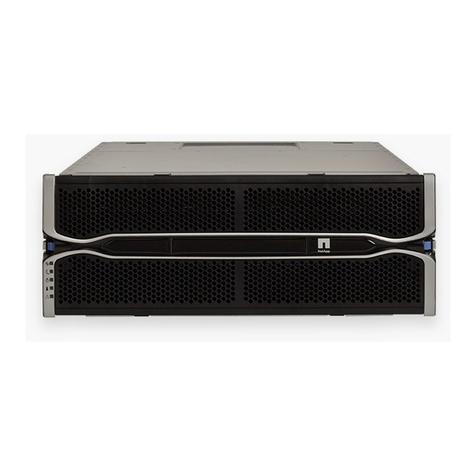
NetApp
NetApp DE6600 User manual
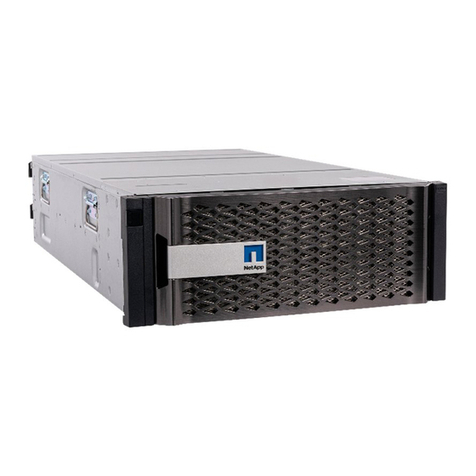
NetApp
NetApp FAS8300 Manual
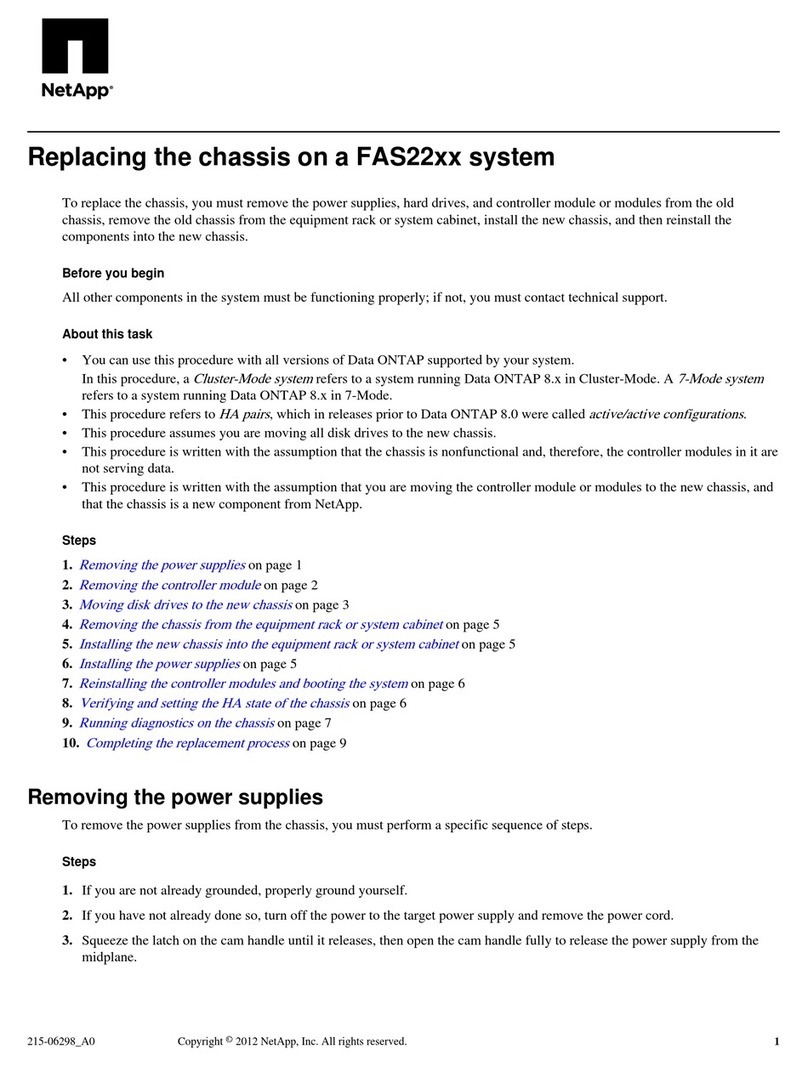
NetApp
NetApp FAS22 Series User manual
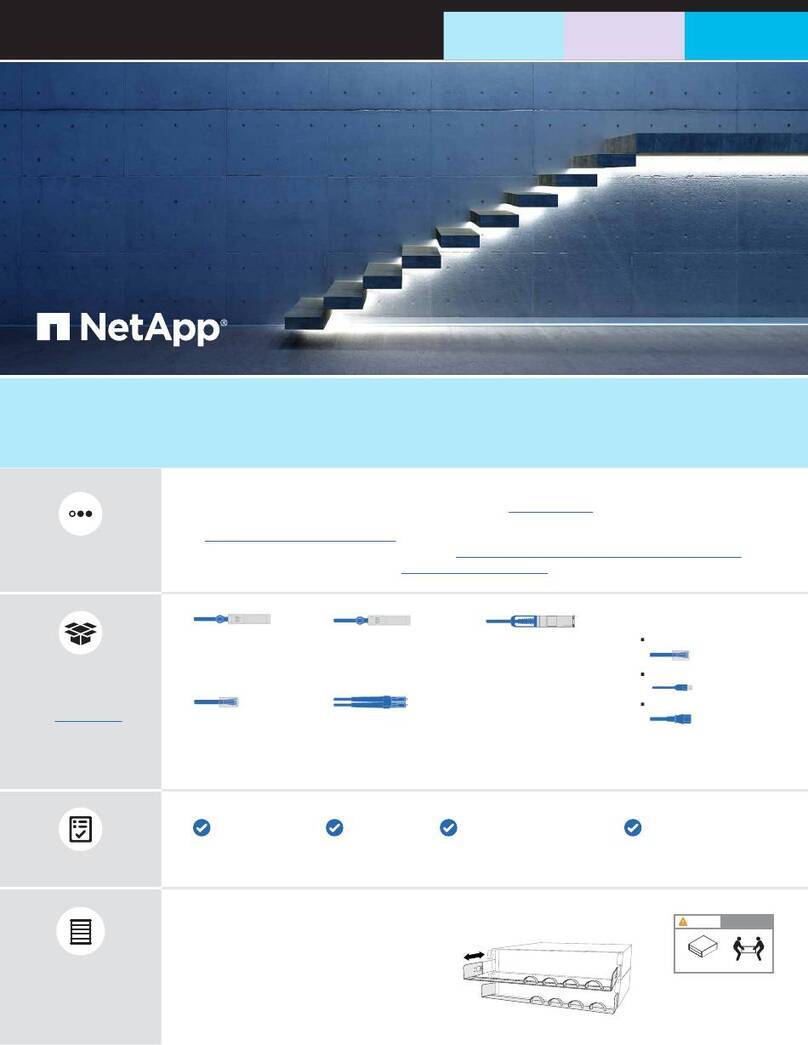
NetApp
NetApp AFF A400 Manual
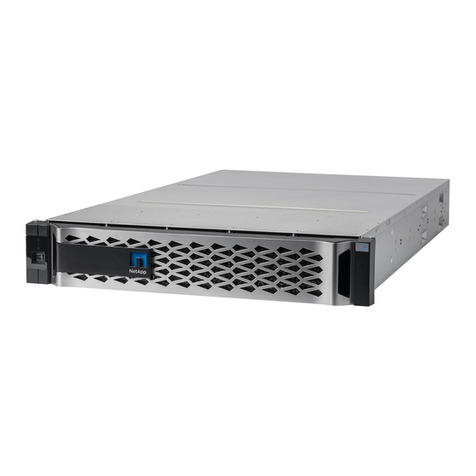
NetApp
NetApp AFF A320 User manual
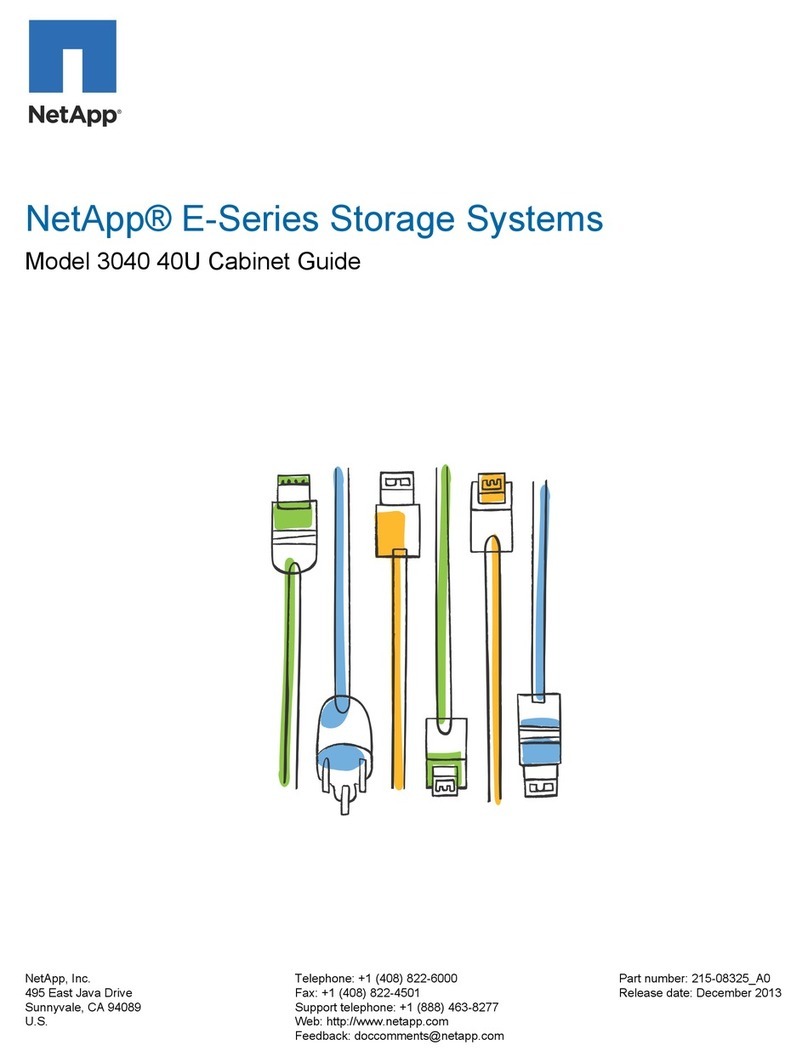
NetApp
NetApp E Series User manual
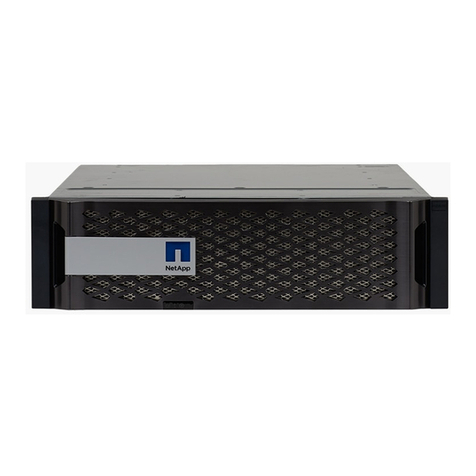
NetApp
NetApp FAS8200 Series Manual

NetApp
NetApp AltaVault AVA400 Instruction Manual

NetApp
NetApp DE6900 User manual
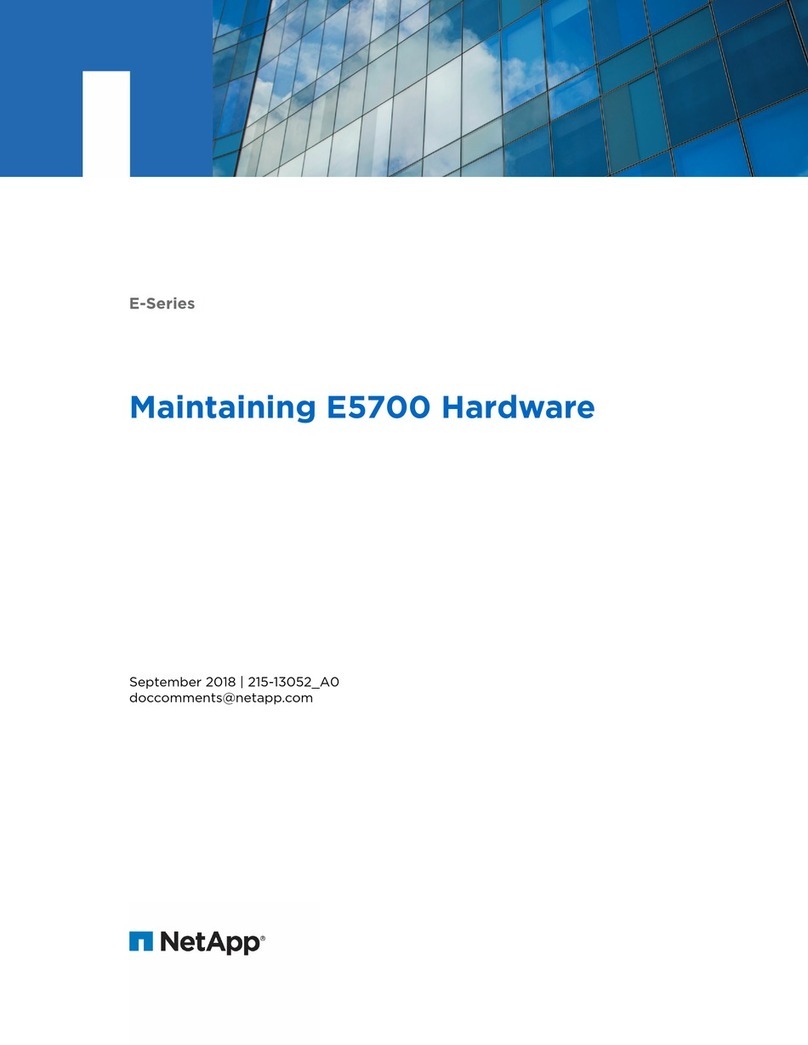
NetApp
NetApp E5700 User manual
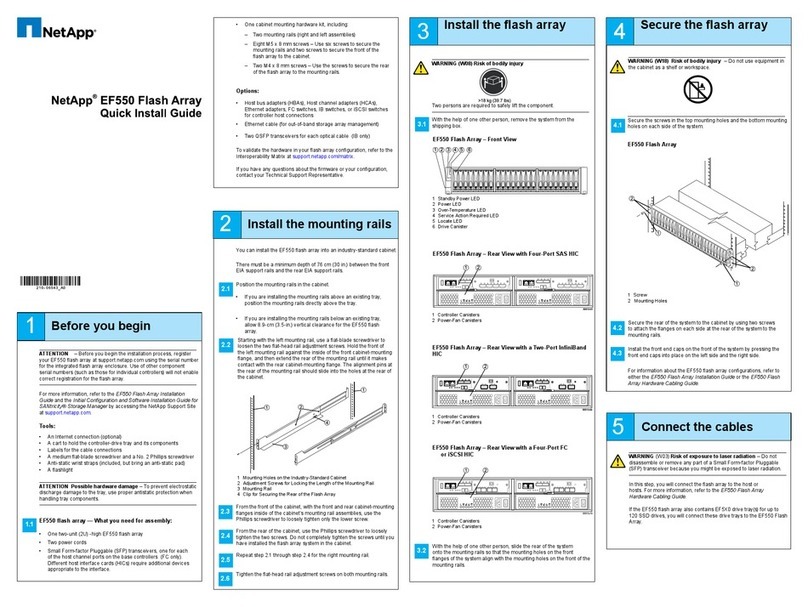
NetApp
NetApp EF550 User manual
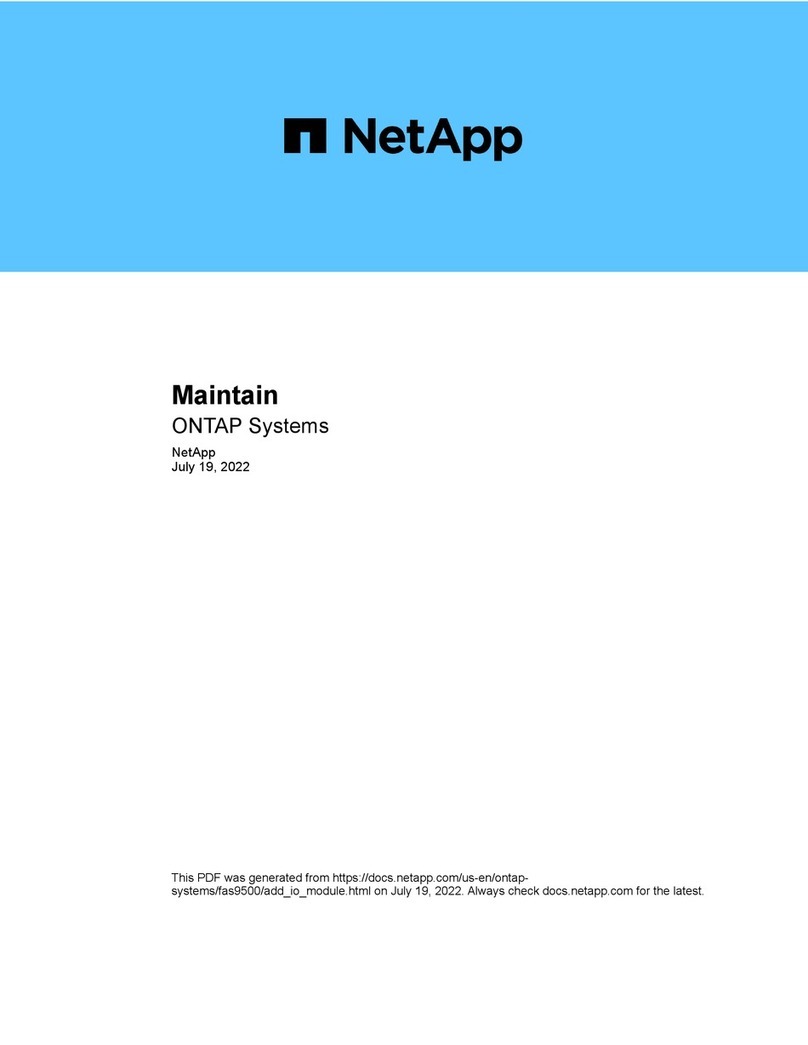
NetApp
NetApp FAS9500 User manual

NetApp
NetApp DS460C User manual

NetApp
NetApp E Series User manual
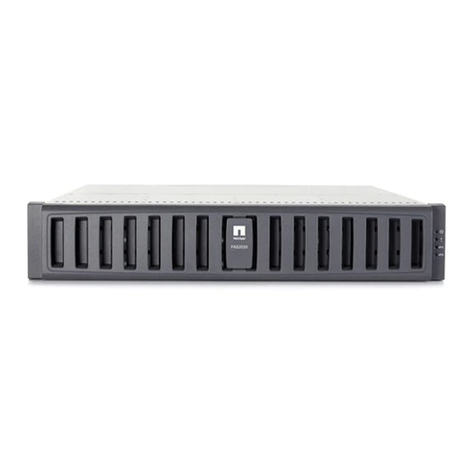
NetApp
NetApp FAS2020 Manual

NetApp
NetApp E Series Instructions for use

NetApp
NetApp AFF A800 Instruction Manual
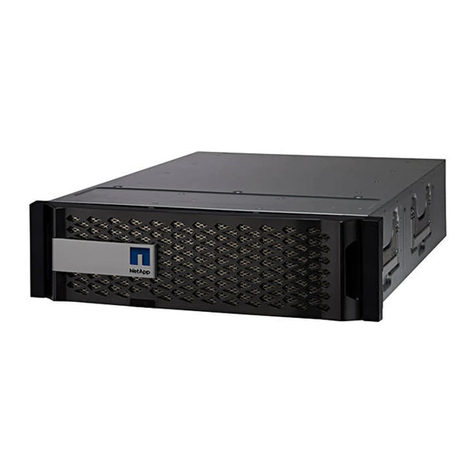
NetApp
NetApp FAS500f User manual
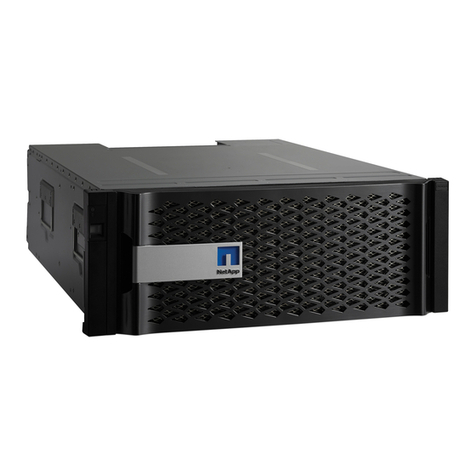
NetApp
NetApp FAS2500 Use and care manual
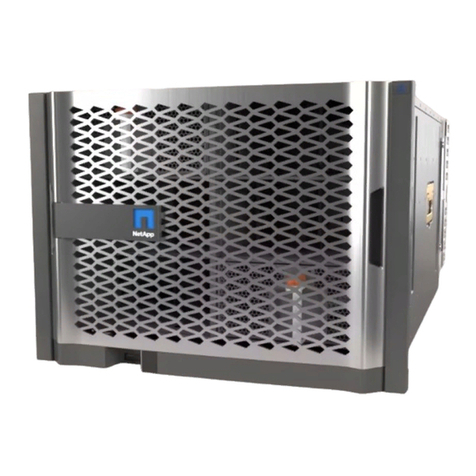
NetApp
NetApp AFF A900 Manual
